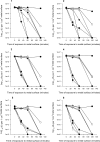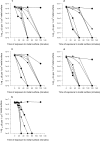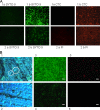Biocidal efficacy of copper alloys against pathogenic enterococci involves degradation of genomic and plasmid DNAs
- PMID: 20581191
- PMCID: PMC2918949
- DOI: 10.1128/AEM.03050-09
Biocidal efficacy of copper alloys against pathogenic enterococci involves degradation of genomic and plasmid DNAs
Abstract
The increasing incidence of nosocomial infections caused by glycopeptide-resistant enterococci is a global concern. Enterococcal species are also difficult to eradicate with existing cleaning regimens; they can survive for long periods on surfaces, thus contributing to cases of reinfection and spread of antibiotic-resistant strains. We have investigated the potential use of copper alloys as bactericidal surfaces. Clinical isolates of vancomycin-resistant Enterococcus faecalis and Enterococcus faecium were inoculated onto copper alloy and stainless steel surfaces. Samples were assessed for the presence of viable cells by conventional culture, detection of actively respiring cells, and assessment of cell membrane integrity. Both species survived for up to several weeks on stainless steel. However, no viable cells were detected on any alloys following exposure for 1 h at an inoculum concentration of <or=10(4) CFU/cm(2). Analysis of genomic and plasmid DNA from bacterial cells recovered from metal surfaces indicates substantial disintegration of the DNA following exposure to copper surfaces that is not evident in cells recovered from stainless steel. The DNA fragmentation is so extensive, and coupled with the rapid cell death which occurs on copper surfaces, that it suggests that mutation is less likely to occur. It is therefore highly unlikely that genetic information can be transferred to receptive organisms recontaminating the same area. A combination of effective cleaning regimens and contact surfaces containing copper could be useful not only to prevent the spread of viable pathogenic enterococci but also to mitigate against the occurrence of potential resistance to copper, biocides, or antibiotics and the spread of genetic determinants of resistance to other species.
Figures








Similar articles
-
Mechanism of copper surface toxicity in vancomycin-resistant enterococci following wet or dry surface contact.Appl Environ Microbiol. 2011 Sep;77(17):6049-59. doi: 10.1128/AEM.00597-11. Epub 2011 Jul 8. Appl Environ Microbiol. 2011. PMID: 21742916 Free PMC article.
-
Mechanism of copper surface toxicity in Escherichia coli O157:H7 and Salmonella involves immediate membrane depolarization followed by slower rate of DNA destruction which differs from that observed for Gram-positive bacteria.Environ Microbiol. 2012 Jul;14(7):1730-43. doi: 10.1111/j.1462-2920.2011.02677.x. Epub 2011 Dec 19. Environ Microbiol. 2012. PMID: 22176893
-
Characteristics of Vancomycin-Resistant Enterococcus Strains in the West Balkans: A First Report.Microb Drug Resist. 2017 Jan;23(1):122-126. doi: 10.1089/mdr.2015.0355. Epub 2016 Jun 28. Microb Drug Resist. 2017. PMID: 27351410
-
The emerging problem of linezolid-resistant enterococci.J Glob Antimicrob Resist. 2018 Jun;13:11-19. doi: 10.1016/j.jgar.2017.10.018. Epub 2017 Oct 31. J Glob Antimicrob Resist. 2018. PMID: 29101082
-
Vancomycin resistant Enterococci: A brief review.J Pak Med Assoc. 2018 May;68(5):768-772. J Pak Med Assoc. 2018. PMID: 29885179 Review.
Cited by
-
Toxicity Mechanisms of Copper Nanoparticles and Copper Surfaces on Bacterial Cells and Viruses.Int J Mol Sci. 2023 Jun 22;24(13):10503. doi: 10.3390/ijms241310503. Int J Mol Sci. 2023. PMID: 37445681 Free PMC article. Review.
-
Transcriptional modulation of Porphyromonas gingivalis biofilms on titanium-copper implant surfaces.Folia Microbiol (Praha). 2025 Feb 15. doi: 10.1007/s12223-025-01246-8. Online ahead of print. Folia Microbiol (Praha). 2025. PMID: 39955444
-
Horizontal transfer of antibiotic resistance genes on abiotic touch surfaces: implications for public health.mBio. 2012 Nov 27;3(6):e00489-12. doi: 10.1128/mBio.00489-12. mBio. 2012. PMID: 23188508 Free PMC article.
-
More Insights about the Efficacy of Copper Ion Treatment on Mycobacterium avium subsp. paratuberculosis (MAP): A Clue for the Observed Tolerance.Pathogens. 2022 Feb 19;11(2):272. doi: 10.3390/pathogens11020272. Pathogens. 2022. PMID: 35215214 Free PMC article.
-
Enhanced peri-implantitis management through purple-LED irradiation coupled with silver ion application and calcium phosphate gene transfection carrier coating.Sci Rep. 2025 Apr 21;15(1):13759. doi: 10.1038/s41598-025-96075-7. Sci Rep. 2025. PMID: 40258901 Free PMC article.
References
-
- Amyes, S. G. B. 2007. Enterococci and streptococci. Int. J. Antimicrob. Agents 29:S43-S52. - PubMed
-
- Borkow, G., and J. Gabbay. 2004. Putting copper into action: copper impregnated products with potent biocidal activities. FASEB J. 18:1728-1730. - PubMed
-
- Boyce, J. M. 2007. Environmental contamination makes an important contribution to hospital infection. J. Hosp. Infect. 65(Suppl. 2):50-54. - PubMed
-
- Casey, A. L., P. A. Lambert, L. Miruszenko, and T. S. J. Elliot. 2008. Copper for preventing microbial contamination, poster K-4121, p. 202. 48th ICAAC. American Society for Microbiology, Washington, DC.
Publication types
MeSH terms
Substances
LinkOut - more resources
Full Text Sources
Other Literature Sources
Molecular Biology Databases

